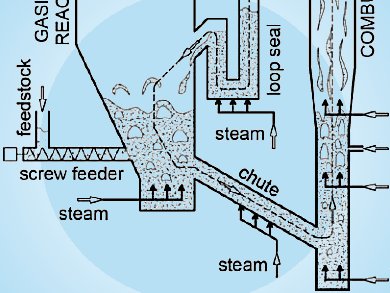Dual fluidized bed (DFB) systems are increasingly used for energy conversion technologies such as steam gasification, sorption enhanced reforming (SER), and chemical looping processes (chemical looping combustion/reforming, CLC/CLR). Johannes Schmid and colleagues, Vienna University of Technology, Austria, gasified different fuels like softwood, hardwood, straw/wood blends, and sewage sludge with the 100 kW DUAL FLUID gasifier at their university at constant gasification temperatures between 800 and 810 °C.
The gasifier system showed to be highly flexible with regard to the application of diverse feedstock. The separation between bubbling bed and freeboard in the classical DFB gasification system is responsible for high solids entrainment, if inhomogeneous fuels with high ash contents like dried sewage sludge, or waste wood are used. Fine ash particles are immediately elutriated into the freeboard and entrained from the gasification zone.
Ashes of different sources seem to have positive influences on the in situ conversion of hydrocarbons, similar to the addition of dolomite powder. An extensive gas–solids contact between bed material, ashy fines, additives, and the gaseous phase is crucial to produce a high quality syngas out of various fuels, varying in composition, size distribution, ash content, and physical conditions.
Therefore, a novel dual circulating fluidized bed (DCFB) concept with improved gas–solids interaction, high residence times, and countercurrent effect in the gasification section is under construction at the university. Multistage solids separation systems for coarse and fine particles on each side will be included in the new system.
- Variation of Feedstock in a Dual Fluidized Bed Steam Gasifier—Influence on Product Gas, Tar Content, and Composition,
Johannes C. Schmid, Ute Wolfesberger, Stefan Koppatz, Christoph Pfeifer, Hermann Hofbauer,
Environm. Progr. Sust. Energy 2012.
DOI: 10.1002/ep.11607




